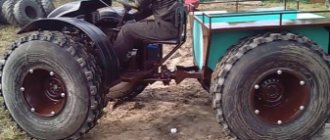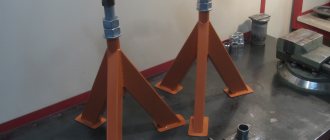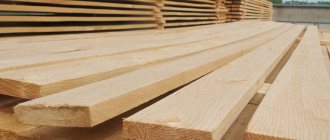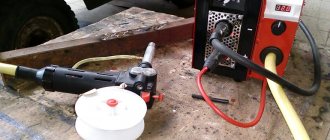Do-it-yourself muffler for an ATV
Home → Tuning → Do-it-yourself tuning of an ATV muffler. Varieties. Methods.
Tuning an ATV muffler can be divided into four types of tasks:
As you can see, each of the above types of muffler tuning solves its own specific problem, but we will try to introduce you to all four types of muffler tuning as briefly and as accessible as possible and give you, as they say, food for thought.
Straight-through mufflers for ATVs.
This type of mufflers is designed to increase engine thrust, lighten the stock design (especially important for sports tuning), and, in addition, these mufflers have a beautiful acoustic effect.
The increase in power occurs due to the fact that all unnecessary elements that can slow down the flow of exhaust gases are removed from the muffler design; roughly speaking, in this case the exhaust flows directly without any obstacles. There are a great many models of direct-flow mufflers for ATVs on sale, but their cost is very high, and therefore craftsmen make direct-flow mufflers with their own hands.
We bring to your attention the simplest diagram of a direct-flow muffler.
And also a finished muffler in section.
And you can appreciate the pleasant and daring sound of a direct-flow muffler by watching this video.
Thermal insulation of the exhaust system of an ATV.
Why is it necessary to thermally insulate muffler pipes and reduce their heat transfer? Most often, this type of tuning is used on ATVs, the exhaust system of which is very close to the gas tank and, during active use of the ATV, brings a lot of trouble to the owner.
There is also an opinion that reducing the heat transfer of the muffler pipes makes it possible to maintain a high temperature of the exhaust gases, which, in turn, increases the flow rate of exhaust gases and has a positive effect on the health of the engine.
To insulate the pipes, a special thermal tape for mufflers is used. There is a tape with a width of 2.5 and 5 cm; for an ATV, the optimal width is 2.5 cm.
When assembling the exhaust system, use a heat-resistant sealant to seal the joints.
Quiet muffler for ATV.
This type of muffler tuning is especially relevant for hunters, but it can also be indispensable for people riding an ATV with a loud exhaust in densely populated areas. The disadvantages include a reduction in engine power when using additional mufflers, although manufacturers claim that this does not happen.
Factory models of additional mufflers (for example, KOLPIN) are very easy to install on an ATV and can also be easily dismantled if necessary, but again it all comes down to money, and ATV riders make an additional can with their own hands and connect it to the main muffler using a small pipe and clamps.
You can listen to the exhaust sound with an additional muffler in the video below.
ATV exhaust pipe snorkel.
Such a snorkel is made solely to avoid water from entering the engine through the exhaust pipe and to easily overcome deep fords.
It is very easy to make the attachment: you can use the muffler pipes of a VAZ car as a donor, selecting the most suitable section in the store, welding the snorkel of the shape and length you need on site, and you can secure the structure with clamps.
If overcoming fords is not a frequent occurrence for you, it is more advisable to use a stainless corrugated pipe (sold in construction or plumbing stores) and attach it with clamps during the “water procedures”.
Well, and finally, we offer you a photo of a frankly brutal exhaust tuning; as you can see, sometimes everything is limited only by our imagination. Good luck off-roading and stay tuned.
Source
What can you make a muffler from with your own hands?
You can implement the idea of how to make a muffler for a car yourself using several schemes, sometimes using unexpected materials. But you need to adhere to the design of the standard part.
From a fire extinguisher
Powder fire extinguishers have found unexpected use in car tuning. To make an effective muffler for your car, start by selecting a suitable sample:
- weight – 3 kg
- flask diameter – from 100 to 150 mm.
This will be the body of the future product. For it, select 2 pieces of solid steel pipes with a cross-section of 30 mm.
Remove the old structure and save the mounting brackets to the car body.
Muffler from fire extinguisher
To make a new muffler for a car, modify the parts:
- Empty the fire extinguisher of its contents by removing the tap.
- Drill the top and bottom parts of the body: the holes should correspond to the diameter of the prepared pipes. Place the inlet and outlet pipes inside the flask so that they do not rest against one another. To achieve this, drill the pipe holes at different levels.
- On sections of pipes that will go inside the housing, make perforations in a checkerboard pattern.
Try on the parts, weld the structure. To give the product a marketable appearance and prevent corrosion, the muffler from a fire extinguisher for a car must be cleaned, degreased, and coated with heat-resistant paint.
From a thermos
You can make an original and cheap exhaust for your car with your own hands from a thermos. The design of the household appliance is convenient in that it has two stainless steel chambers.
Drill 5-6 mm holes in the lower part of the inner flask: here the exhausts will encounter some resistance. Cut a gap in the bottom of the outer casing for the exhaust pipe and weld it. Reinstall the assembly.
Muffler from a thermos
A homemade part can be used as a nozzle for a straight line, or as an independent component of the exhaust system.
Made of stainless steel
Another interesting way is to make your own muffler for a car from stainless steel. Such a thing will serve for a long time and look beautiful on the car.
- Take a piece of stainless steel with a cross-section similar to the standard part.
- Place several household metal sponges on the pipe.
- Wrap the structure with fine mesh and wrap it with steel wire.
- Insert the sandwich into a larger diameter pipe. You can also wrap the structure with a sheet of stainless steel and rivet the seam.
- Stuff mineral wool (ursa) inside.
- Cover one end of the resonator with a mixture of ursa and cement (ratio 1 to 3).
Muffler modification + extra. muffler
So another modernization, this time – a muffler.
First, a little theory: the designers of our quad designed it in such a way that the CDI ignition system gives a very weak spark for such an engine size, so the unburnt air-fuel mixture flies out into the pipe along with the exhaust, and in order not to pollute the environment, they decided to burn it all out in the muffler! And to do this, they placed ceramic honeycombs inside the muffler and came up with an “ecological box” that sucks fresh air into the muffler so that all unburnt fuel and other “poop” burns on these hot honeycombs (like in a car’s catalytic converter).
DIY ATV muffler tuning
Tuning an ATV muffler can be divided into four types of tasks:
— Reduced exhaust noise.
— Increased engine power by installing a direct-flow muffler.
— Installation of a snorkel on the exhaust pipe of an ATV (for those who like to swim).
As you can see, each of the above types of muffler tuning solves its own specific problem, but we will try to introduce you to all four types of muffler tuning as briefly and as accessible as possible and give you, as they say, food for thought.
Tuning at the Lyokha Exhaust car service center.
The best specialists of our Lyokha Exhaust car service center will be able to competently perform tuning, manufacturing or repair of the muffler of your ATV at the best prices! All installation work will have its own guarantee. You will be offered various tuning services to also improve the performance of the vehicle. You can resolve any issue at the address: Moscow, Sokolnichesky Val 1, building 1.
ATV muffler - tuning, manufacturing, repair - photo, video, Instagram
Also, you can read Exhaust system that increases car power
Straight-through mufflers for ATVs
This type of mufflers is designed to increase engine thrust, lighten the stock design (especially important for sports tuning), and, in addition, these mufflers have a beautiful acoustic effect.
The increase in power occurs due to the fact that all unnecessary elements that can slow down the flow of exhaust gases are removed from the muffler design; roughly speaking, in this case the exhaust flows directly without any obstacles. There are a great many models of direct-flow mufflers for ATVs on sale, but their cost is very high, and therefore craftsmen make direct-flow mufflers with their own hands.
Thermal insulation of ATV exhaust system
Why is it necessary to thermally insulate muffler pipes and reduce their heat transfer? Most often, this type of tuning is used on ATVs, the exhaust system of which is very close to the gas tank and, during active use of the ATV, brings a lot of trouble to the owner.
There is also an opinion that reducing the heat transfer of the muffler pipes makes it possible to maintain a high temperature of the exhaust gases, which, in turn, increases the flow rate of exhaust gases and has a positive effect on the health of the engine.
To insulate the pipes, a special thermal tape for mufflers is used. There is a tape with a width of 2.5 and 5 cm; for an ATV, the optimal width is 2.5 cm.
The tape must be pulled very tightly, and the turns must be secured with thin stainless wire, since the tape tends to stretch over time.
When assembling the exhaust system, use a heat-resistant sealant to seal the joints.
Making a muffler for an ATV.
The muffler is one of the components of the exhaust system, where its structure consists of several components. In the manufacture of a muffler, the following materials are most often used:
- Titanium;
- Stainless steel;
- Aluminized steel;
- Carbon;
- Plastic.
The manufacture of an exhaust system with a muffler is quite simple:
- Coordination of the task and goals during production.
- Design.
- Manufacturing.
- Installation.
When working, our specialists use various types of steel, titanium, aluminum
We manufacture exhaust systems for any type of transport
Go to our gallery to see even more photos of exhaust systems and our work
Quiet muffler for ATV
This type of muffler tuning is especially relevant for hunters, but it can also be indispensable for people riding an ATV with a loud exhaust in densely populated areas. The disadvantages include a reduction in engine power when using additional mufflers, although manufacturers claim that this does not happen.
Factory models of additional mufflers (for example, KOLPIN) are very easy to install on an ATV and can also be easily dismantled if necessary, but again it all comes down to money, and ATV riders make an additional can with their own hands and connect it to the main muffler using a small pipe and clamps.
Tuning the muffler of an ATV.
In tuning ATVs, modifications such as:
- Thermal insulation of the exhaust system;
- Tuning to reduce noise;
- Increased engine power;
- Installing a snorkel on the exhaust pipe of an ATV.
ATVs are designed for more extreme riding than cars, and the hot muffler is regularly exposed to high temperatures and doused with cold water, which after a certain point causes corrosion. It also often happens on an ATV that the standard mufflers are not particularly durable, which leads to the desire to tune it.
ATV exhaust pipe snorkel
Such a snorkel is made solely to avoid water from entering the engine through the exhaust pipe and to easily overcome deep fords.
It is very easy to make the attachment: you can use the muffler pipes of a VAZ car as a donor, selecting the most suitable section in the store, welding the snorkel of the shape and length you need on site, and you can secure the structure with clamps.
If overcoming fords is not a frequent occurrence for you, it is more advisable to use a stainless corrugated pipe (sold in construction or plumbing stores) and attach it with clamps during the “water procedures”.
Source
MY MOTORCYCLE
Today, society and the governments of the world's leading countries are highly concerned about environmental problems, engineers are developing ultra-modern electric vehicles, and internal combustion engines and exhaust systems of cars and motorcycles are designed in such a way as to release as little harmful substances and carbon dioxide into the atmosphere as possible.
However, at the same time, the demand for powerful engines, high-speed cars and motorcycles, as well as all-terrain SUVs and ATVs is not falling at all. On the contrary, powerful engines are attracting more and more attention and fans of such equipment are increasingly thinking about making their favorites even more powerful on their own, squeezing a few extra horsepower out of the engine, adding stylish body kit elements and external tuning. In a word - to make their vehicle as different as possible from stock and have a better chance of outperforming its rivals.
One of the first components to be replaced is usually the exhaust system. There are a lot of reasons to get rid of the standard muffler - we will talk about them using the example of an ATV. Often, the exhaust pipe of an all-terrain vehicle is the first place where the main enemy of any equipment appears - corrosion. It affects the muffler not only from the outside, but also from the inside. If the external factors due to which the first “saffron milk caps” appear on the metal include, first of all, weather conditions and dirt, which ATVs love so much, then inside the exhaust system is exposed to a much more aggressive effect. Hot exhaust gases constantly pass through it, condensation from moisture and acid settles on the internal surfaces - it is not surprising that not only the walls, but even the welds are subject to corrosion. It is naive to believe that this problem can only be solved by cleaning and painting the muffler. Those who have already encountered such a problem clearly know that it is better to change the stock muffler.











